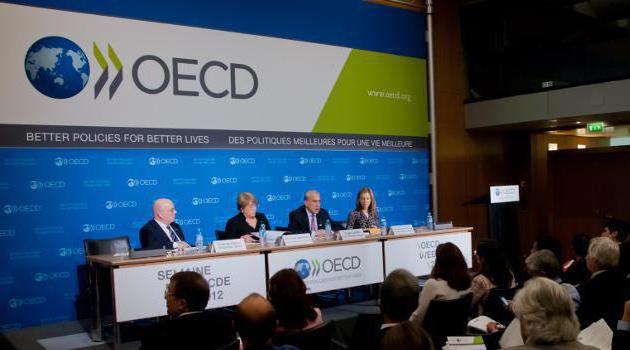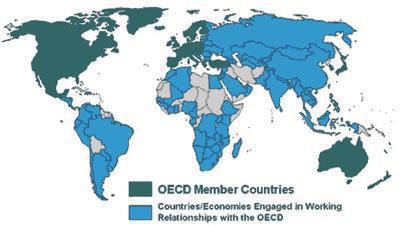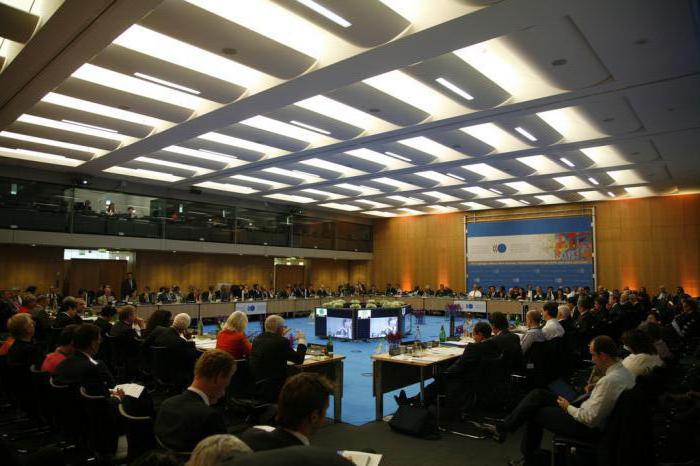Organization for Economic Co-operation and Development (OECD) is an interstate international organization consisting of advanced economies based on freedom of market relations and democratic principles. Often it is called the Club of developed countries. The Organization for Economic Cooperation and Development is a negotiating platform operating in the format of a forum where its members can hold consultations, look for ways to resolve common economic problems, and develop common positions on specific issues.
History and background
The main document, the signing of which led to the emergence of this organization, is the Marshall Plan and the European Recovery Program developed on its basis. For coordination between countries on this program, a common platform was needed, therefore, in June 1947, the Committee for European Cooperation and Development was founded. The initiators of the convocation are the Foreign Ministers of Great Britain and France.
Following the results of the first conference, the committee included 16 participants. The main task of the committee was announced to draw up and present a four-year plan to restore the economy of post-war Europe. Within the committee, additional commissions functioned. The main center for generation and decision-making was designated the Executive Committee, consisting of 5 founding states: the Netherlands, Norway and Italy, as well as the dominant France and the UK. However, the first development plan received as a result was criticized by the American side and was not approved. After reaching a compromise on all issues, the Committee was reorganized. The successor was the organization of economic cooperation and development, founded by the same 16 countries.
In the statutory documents, the objectives of the OECD activities were:
- trade and production assistance between members of the association;
- creation of a mutual payment system;
- strengthening and stabilization of exchange rates;
- trade liberalization: simplification of trade relations and reduction of mutual restrictions.

OECD Initial Stage
The first four years of work were aimed at assisting in the implementation of the Marshall Plan, according to which investments in European countries amounted to more than 20 billion US dollars. Thanks to the developed economic strategy, by 1952 it was possible to achieve more than 200% growth in production in European countries, compared with pre-war indicators.
OECD activities have also had a positive effect on post-war integration processes. Within the organization, the European Payment Union was founded. Having existed until 1958, the ENP played a significant role in strengthening the convertibility of monetary units in Western Europe. The growth of production and trade between the OECD countries was also facilitated by the Trade Liberalization Code, adopted as part of its forum. Finally, the modern structure of international education was formalized when all OECD countries signed and ratified the Convention on the Establishment of the Organization for Economic Cooperation and Development.
Finally, the modern structure of international education was formalized when all OECD countries signed and ratified the Convention on the Establishment of the Organization for Economic Cooperation and Development.
Objectives and activity
The main objectives of the structure were set out in the first article of the Convention. The work was determined in the coordination and implementation of policies in the following areas:
- economic growth and improving living standards in the participating countries;
- promotion of promising economic models of state development;
- promotion of mutually beneficial international trade between partners under the Convention.
 For the implementation of the approved tasks, the OECD countries have undertaken the following obligations:
For the implementation of the approved tasks, the OECD countries have undertaken the following obligations:
- open access for site participants to the economic information necessary to complete tasks;
- ensuring the correct use of economic resources;
- participation in joint projects;
- stimulation of research activities aimed at economic growth;
- liberalization of international cooperation;
- assistance to third world countries in the development of their economies;
- harmonization of measures and actions within the OECD.
Organization for Economic Cooperation and Development: Key Activities
Directions of the forum:
- trade;
- macroeconomic activity;
- consultations on tax and budget policy issues;
- employment and social policy issues;
- development of scientific and high-tech projects;
- informational support of member countries, as well as other partners.
Organization Structure
The governing body is the Council of the organization. It has one representative each, delegated by all OECD members that have accepted the Convention. The Council meets on an ongoing basis, led by the Secretary General. The work of the structural body is provided by the Secretariat, and the preparation of the forums is carried out by various directorates and committees created within the framework of the structure.
OECD-Russia
Russia began a partnership with the OECD in 1994 by signing a joint declaration of cooperation. It, in particular, noted the commitment of the structure to help the Russian Federation in integration into the global market economy.
In 1995, Russia submitted an application for membership in the OECD, but it was not approved, and in 2014, as a result of complex political processes associated with Ukraine, it was frozen.
